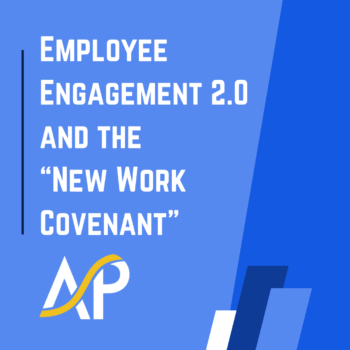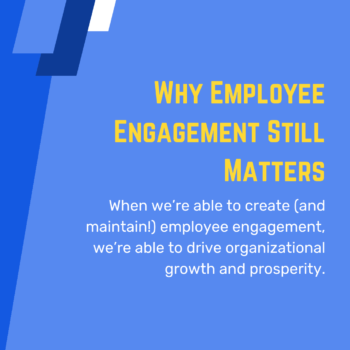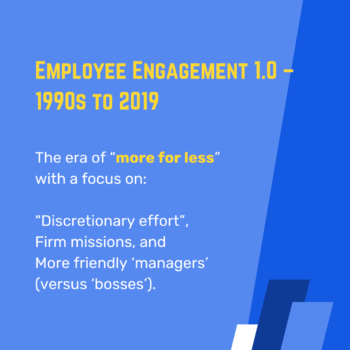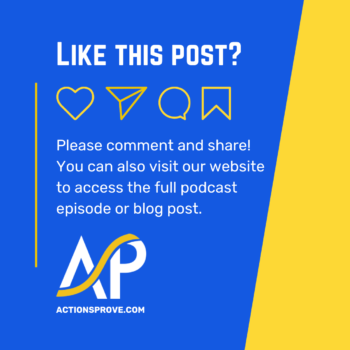Employee Engagement 2.0 and the “New Work Covenant”
Employee Engagement 2.0 and the “New Work Covenant”
As I work directly with dozens of executive leaders and speak at conferences and events around the country, I continue to hear a lot of concern about employee productivity and workplace culture and whether to remain hybrid or work flexible.
This is the wrong concern.
The right concern for those seeking next-level success in this new era is to ensure that those who are leading others understand how best to engage and draw the best from them, no matter their location.
Over the past 30 years, there has been a steady and profound evolution in terms of what attracts, inspires, and engages great talent.
Whether those on our teams serve mostly from an office or from home, traditional employee engagement and the old work accords we’ve come to know are not enough.
There is, however, a very clear new formula that, when understood and employed, is helping more and more leaders and organizations succeed, while others remain talent starved and growth limited.
Why Employee Engagement Still Matters
Employee engagement drives value.
When we’re able to create (and maintain!) employee engagement, we’re able to produce value both internally – through the development of processes, systems, and critical business support, and externally – through the delivery of client-facing projects and services.
This is illustrated in what I call the “Target Logic Model for Work Today” which I originally developed as part of my first book, Reversing Burnout, back in 2017, and which is included in the image below:
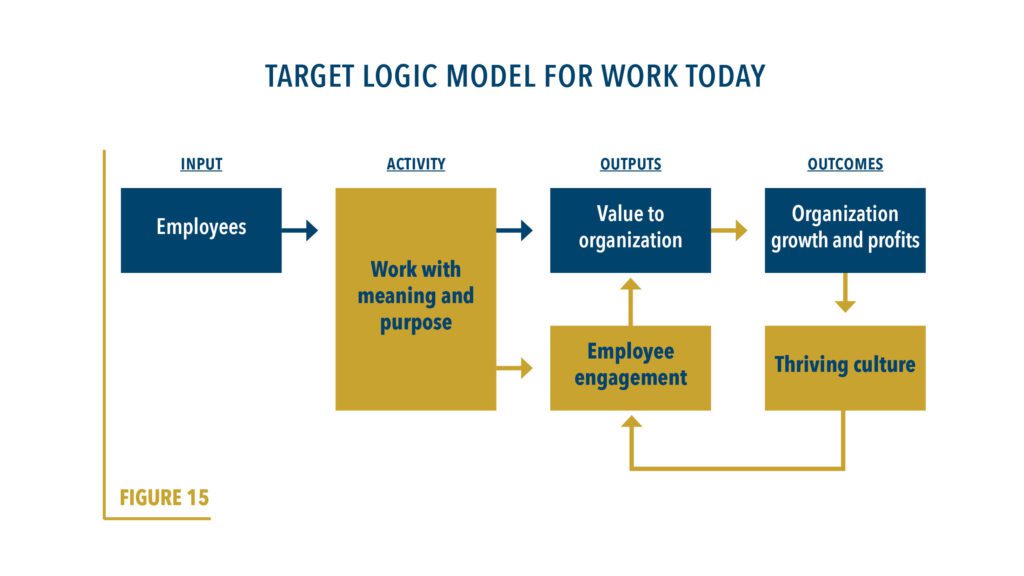
From a ‘big picture’ perspective, if we have good people doing good work that produces both internal and external value, we are positioned to achieve organizational growth and profits. However, being able to create and maintain employee engagement does not just ‘happen’.
Employee engagement itself is an ‘output’, and not something we can just ‘turn on’… and while the ‘output’ and ‘outcomes’ of having employee engagement have not changed, the activities that produce it have.
Employee Engagement 1.0 – A History Lesson (or Walk Down Memory Lane)
The idea of “employee engagement” arrived in the mid to late 1990s.
This was a time of significant change: personal computers at work, professionals picking up more administrative tasks, and more design work being done by younger engineers and architects via this new thing called ‘CADD’.
This was also a time of “re-engineering the corporation” – basically the gutting of middle management across sectors, and a recession.
All in all, this was the official birth of having to “do more with less”.
In these early days, there was a term used to signify employee engagement. It was “discretionary effort”. This was the additional time expected to be put in outside of normal working hours to get the job done.
“ ‘Employee Engagement 1.0’ was flawed from the start as it never connected to what it means to be a human and perform at a high level together over time.”
– Peter C. Atherton, PE
‘More for less’ continued into the 2000s and 2010s and became even more acute as we worked though the Great Recession and the ‘slow to hire’ decade thereafter – eventually becoming a way of life.
Leveraging effort was not the only facet of Employee Engagement 1.0 – so was leveraging emotion, which took two forms. First was the more widespread development and use of an organization’s mission and vision – work was now to be about helping the organization achieve its goals and objectives. Second was the transition from having a ‘boss’ to now having a much more friendly and connected ‘manager’ to make the new way of working feel or seem less isolating.
The results were powerful in terms of employee productivity, but also began to spur much broader levels of overwhelm, burnout, and “opt-out” – destabilizing elements we’re still dealing with today.
Employee Engagement 2.0 – A Post-Pandemic Reality
COVID-19 changed the work world. There is no denying that.
The reality is, trying to extract more effort from employees who are already working hard and putting in extra effort is not engaging. Nor is it engaging to try to draw more on an employee’s emotions with all we’ve been through.
What does engage employees in this new era is our ability to become a more positive source and amplifier of ‘energy’ and to create greater work-life and career ‘alignment’.
Said another way, continuously taking from an employee’s ‘energy pool’ is not a recipe for our success, especially when the world around us consumes more and more of it – physically, spiritually, and emotionally.
Being misaligned at work leads to a similar fate, especially given the rise of personal agency and our overwhelming desire for greater work-life balance and integration.
The “New Work Covenant™”
To effectively increase an employee’s energy and alignment, we must redefine our overall working agreement or pact between employer and employee, and supervisor and employee.
“What I see working across high performing teams and organizations is what I have developed and call the ‘New Work Covenant’.”
– Peter C. Atherton, PE
What I see working across high performing teams and organizations is what I have developed and call the “New Work Covenant”.
This new framework has five progressive elements.
A summary of the five elements and a brief description of each is provided below:
- More Meaningful Work – Whether work ‘serves a purpose’, is something we ‘find purpose in’, or is part of our ‘life purpose’, we (and our employees) desire work with greater meaning and purpose, aligned with personal and professional goals, interests, passions, and work and life seasons. This ties directly into the “Target Logic Model” shared above. We can only know what’s truly meaningful to others when we effectively ask, and they willingly tell.
- Genuine and Work-Productive Relationships – Employees, like all humans, want to be seen, heard, valued, and belong. This addresses the lower portion of Maslow’s hierarchy of needs. In a work context, they also want to be a part of a high-functioning team with support, trust, and respect. Genuine relationships are what allows for real connection. Work-productive relationships are what allows for work success.
- Open Transactions – If employees are to perform at a high level, they want (and need!) greater clarity on role and function, what “winning” looks like, and the expectations of them in terms of time, effort, outputs, and outcomes. They also want to know how they and others benefit from achieving success. This cannot effectively happen without Item #2 listed above and more leadership courage and transparency.
- True Growth – Work must lead to growth – personal and professional, horizontal and vertical, and season-specific. This is equivalent to “self-actualization” and should never be ignored.
- Tangible Impact – Work that an employee does must also make a difference beyond themselves and their organization. This can be tied to our project and/or community work. This is equivalent to “transcendence”, what ultimately leads to contentment and further investment.
Employee engagement is as much about leadership as it is about personal responsibility.
Being able to see, understand, and effectively lead through the “New Work Covenant” in a truly caring and purposeful manner, is the only way I see to increase individual and collective employee energy and alignment.
Doing so is powerful.
Being able to truly engage employees in this new era is a differentiator.
Being able to truly engage also allows for:
- Greater performance and employee “opt-in” at any point in a project,
- Greater success from any location,
- Greater access to a larger talent ecosystem, and
- The creation of a self-reinforcing thriving firm culture (which you can also connect with me to talk more about).
To learn more about:
To your winning,

PS – Ready to help position you and your firm for greater success? Check out our Strategic Planning, Leadership and Management Team Training and Development, and Executive Coaching and Mastermind programs.
PSS – Are you a leader who wants to stay relevant and effective and help your firm grow and prosper? Check out the AEC Leadership Today Podcast designed exclusively for you HERE!
PPPS – You can also join the pre-launch community for my new book, The Team Success Ecosystem, and gain early access to key new concepts (like those included in this article!) and events HERE.

Pete Atherton
About the Author
Peter C. Atherton, P.E. is an AEC industry insider with over 30 years of experience, having spent more than 24 as a successful professional civil engineer, principal, major owner, and member of the board of directors for high-achieving firms. Pete is now the President and Founder of ActionsProve, LLC, author of “Reversing Burnout. How to Immediately Engage Top Talent and Grow! A Blueprint for Professionals and Business Owners”, and the creator of the I.M.P.A.C.T. process.
Pete is also the host of The AEC Leadership Today Podcast and leads The AEC Leadership Mastermind.
Pete works with AEC firms to grow and advance their success through modern and new era focused strategic planning, executive coaching, leadership and management team development, performance-based employee engagement, and corporate impact design. Connect with him through the contact link below.
